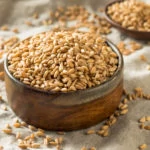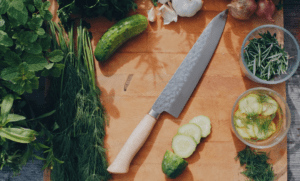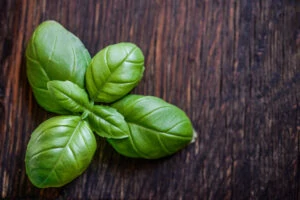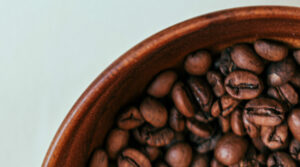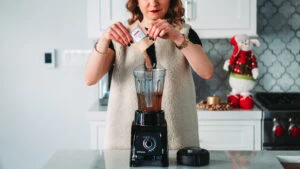So, here are some tips on how to reduce food waste in your kitchen. It’s pretty easy to eliminate food waste at home, but little things creep in. You’ve been foiled by the fickle avocado again. Another $2.99 in the trash. The bananas went bad while you weren’t looking. And how long ago did you get that Thai takeout?
It stings every time you throw away food scraps that you paid for, and the United States is hurting bad. The USDA estimates that 30 to 40% of our food supply becomes food waste when both the waste at the retail and the home kitchen environments are considered.
The area that’s under your control is the area within your home, and within that space, there’s plenty you can do. Food scraps are wasted when we:
- fail to use all the edible parts of a plant
- miss the “best by” date and simply throw it away
- don’t know how old leftovers are, so we think better safe than sorry (always follow food safety guidelines), and put them in the trash
(Read more on reducing wasted food at Food and Agriculture Organization of the United Nations)
But you’ll have to take fewer trips to the trash can outside, fewer trips to the store, and fewer dollars out of your bank account if you get smarter about how you manage food in your home.
The Benefits of Eliminating Food Waste
There are a bunch of benefits to avoid wasting edible food, and the benefits cutting food waste at home make a big impact on our health:
Save Money
Using up more food, buying less food, and reducing how much you waste helps you save money and reduce household waste because you don’t have to restock as often.
Reduce Greenhouse Gas Emissions
Cutting out wasted food by shopping less often, buying just what we need, and digesting healthy foods are ways to reduce greenhouse gas emissions and lighten Earth’s workload a little.
Tips on How to Eliminate Food Waste at Home
Make sure to find a use for every food item that is edible. For example, broccoli stalks are wonderful in a salad when sliced or spiralized. The ends of green onions can be put in water and will grow your new green onions!
Make soup stocks with surplus food
Make stock out of what you can’t eat. Our society is so used to using packaged food like canned chicken stock and we’ve forgotten about the real thing. Next time you buy a rotisserie chicken, use the scraps in a slow-cooker chicken soup, or simply make and freeze a stock.
Greens wilting? Get them on some heat
Put that soggy spinach and other perishable items like fresh fruits and vegetables in the skillet (getting rid of any slimy pieces). Put some oldish arugula on a pizza. Voila.
Use up excess food like eggs
Check out recipes for frittatas, quiches, and custards.
Eat all the food, including cheese rinds!
Parmesan rinds make amazing stock. The longer you steep it, the more flavor you’ll get. Make sure you dig it out before you serve.
Eat foods like bread before they mold
Toast the bread and put it in a food processor to make bread crumbs.
When in doubt, throw it out
According to the FDA, the maximum time you have for open food is seven days. Check out the expiration dates on the food labels to be safe while you work to not waste so many perishable foods. Keep a permanent marker attached to your fridge so you can mark the day you opened items like spaghetti sauce and almond milk.
Use the raw stuff quick! Raw meat only lasts 3-4 days, and poultry 1-2. Even cooked meat shouldn’t be around for more than half a week.
How to tell if food is off
Reducing food waste isn’t about eating bad food: treat your body well! You evolved your nose for a reason. Trust it for cutting food waste! Smell for any rancid odor. Eggs that smell like sulfur are no good.
Look closely as well. Inspect the texture, make sure those bumps in the bread are seeds and not mold, and throw out anything from the freezer caked in frost. Fruits and vegetables that are bad are usually dull in color, mushy, bruised, or have moldy spots.
Some foods, like hard salami and cheeses, can be saved if you surgically remove any bad areas. Try for at least an extra inch around any mold, and don’t let the knife touch the moldy part.
Food storage: store food properly
Sometimes I can’t believe how much food I actually have in the fridge that’s going bad already. Maybe you have too much food, it’s nearly expired, and you know you’re not going to use it in the next few days. Pause the clock by freezing it!
Most items are freezable, even though some, like yogurt and cheeses, can change texture when frozen. To use the freezer well, put room temperature or cool items only in there. (Heat encourages the dreaded freezer burn.) Try to get out as much air as you can from the container. And be sure to label what it is and when you put it in there.
And speaking of the freezer, another way to reduce food waste in your produce drawer is to buy only what you need and buy it frozen in the first place. You can have greens on hand when you need them, without having to worry about what day you have to use them.
How to Use Scraps
If you do have to throw out food. Give wasted food a second life by using it as compost. See if there’s a composting program in your town. If not, contact a farm or start your own compost bin and use the waste in your own yard. Composting is easy and it keeps your kitchen scraps out of the landfill.
It can feel like a small thing to avoid wasting food, but over your lifetime, managing the waste coming out of your kitchen can make a huge impact on your family’s budget and the health of the environment. There’s just nothing sadder than seeing leftover food like a delicious half-eaten peach that gets tossed. Avoid these tiny tragedies with the tips above.




